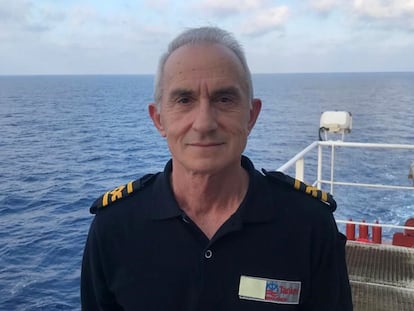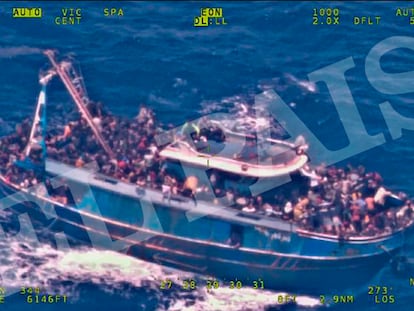The 11-hour anguished search for survivors of the shipwreck in Greece: ‘Ship sinking. We’re asking you to come to the rescue’
In the early hours of the morning of June 14, the captain of an oil tanker received a call to help save the trawler that sank 30 miles off the coast of Greece. The sea had swallowed everything up. Navigational data show contradictions in Greece’s official account of events

It was a clear, windless dawn, and the sea was as smooth as glass. The Rekon, a 122-meter Maltese-flagged tanker, was going about its route to the port of Haifa in Israel. Then the radio announced a distress call: “Ship sinking. Large number of people. Vessels in the vicinity are asked to proceed with search and rescue operations.” The officer immediately alerted the captain. It was June 14 at 2:12 a.m. local Greek time.
Captain Sait Bektasoglu, a 63-year-old Turk with four decades of experience at sea, ran to the bridge. “We changed our course immediately to the wreck site, we adjusted our radars for sensitivity, and I mobilized the crew,” he recalls. His account of 11 hours of fruitless searching is harrowing and rich in heretofore unknown details.
It took the Rekon an hour and 15 minutes to reach the coordinates it received, an area some 50 miles off the Greek coast. When it arrived, the luxury yacht Mayan Queen IV and two other cargo ships were already searching the water for survivors. The tanker then slowed down, turned on its search lights and its crew of 14 sailors began scanning the vast stretch of black water with binoculars. They didn’t see or hear anything. “It was as if nothing had happened,” recalls the captain. “There were no life jackets, no floats, no trace of oil, no trash, no floating material from the ship, nothing,” he recounts.
The Adriana, a ramshackle fishing boat of about 25 meters, had set sail for Italy with some 750 occupants on board. Women and children were crammed into the hold and many of the men were on deck. They were Syrian and Afghan refugees, Egyptians, Pakistanis and Palestinians. The Greek authorities had been aware of the ship’s presence since 11 a.m. on June 13 and, in addition to keeping it under surveillance, ordered two ships in the area to deliver food and water to those onboard. They never activated a rescue operation, despite the conditions in which the ship was sailing, not even when the ship’s engine broke down at 1:40 a.m. Between 2:04 a.m. and 2:19 a.m., the old metal fishing trawler jolted violently and then disappeared right before the eyes of the Greek coastguard. It is still not clear what happened, but the sea swallowed everything up.
Greece’s official version of events claims that the castaways refused any help and continued on their way to Italy. But navigation data contradicts that assertion. The coordinates of the distress call place the trawler just over a mile from its location at 7.30 p.m. when a first vessel approached it to supply it with food. In other words, in the seven hours between the delivery of supplies and when it sank, the Adriana was not approaching Italy as the Greek authorities claim; the ship made practically no progress and moved just over a mile away towards its presumed destination.

While Bektasoglu was scanning the sea from the deck, between 3:00 and 4:00, a Greek patrol boat arrived and took command of the operation. The radio continued to instruct nearby vessels to approach the area. One passenger cruise ship, the Celebrity Beyond, “asked if it could lower its rescue boat and join the search, but was told no,” Bektasoglu explains. “There were already too many ships searching without detecting anything,” the captain theorizes. As many as eight large ships participated in the search for survivors. EL PAÍS unsuccessfully tried to contact them all.
The radio was constantly broadcasting messages to all the ships involved in the rescue. The Mayan Queen IV, a luxury yacht owned by a multimillionaire Mexican family, reported that it had already pulled a hundred or so castaways out of the water alive. “I don’t know how it sank at a depth of 4,500 meters, but I am sure that if this superyacht had not been there, the freighters could not have rescued more than two people each. The survivors were lucky to come across a ship that could rescue them and reunite over 100 people. A superyacht is much better equipped than the coast guard boats,” Bektasoglu explains.
“I couldn’t stand it,” Bektasoglu recounts. “I suggested that [the Turkish bulk carrier] ask the cruiser for help, but he was ordered to wait. [The Rusander] kept asking for medical assistance for more than an hour, and again I recommended that he approach the cruiser for help. They ignored me in both Turkish and English,” the veteran sailor maintains.
The helicopter finally appeared as dawn was breaking. “It picked up the living and the lifeless bodies that were transferred to the Greek ship,” Bektasoglu explains. A new Greek patrol boat joined the operation. In all, 81 bodies were recovered.
The veteran captain, who had gone 11 hours without rescuing anyone, eating or sleeping, began to lose hope. “We did not experience a chaotic situation because there was nothing to be seen, there was no dramatic scene. The water was still like a mirror and after a few hours we lost morale,” he explains.
At 7:00 a.m. he asked for permission to continue his trip but was denied. A half an hour later, a military frigate arrived, took over command and gave the ships new coordinates to continue the search. “They sent me to two different places, I increased speed, arrived and searched,” he recounts. Again, the search was unsuccessful. Over the radio, he heard a freighter being ordered to “raise your boat, pick up the body and bring it to the Greek ship.” Other ships also used their lifeboats, while two helicopters flew overhead, he says.
The Turkish captain appreciates the measures the Greeks deployed, even though they only activated the search and rescue operation when the trawler was already sinking. “For several hours they deployed a plane, a patrol boat, two coast guard frigates, a rescue ship, three helicopters and a navy frigate; it’s a great effort,” he says.
At 8:30 a.m., Bektasoglu tried to leave again. He was in a hurry because he had to unload 5,200 tons of methyl tertiary butyl ether (a liquid that increases fuel efficiency) in Israel and then arrive in Tuzla, Bosnia-Herzegovina, by June 20. He was not cleared to leave the operation until 11:45. As he left, he heard other ships being radioed to join the search. “I was tired, went to the bridge at 2.20 and couldn’t stop for lunch until after 12:00 the next day. I spent 11 hours on the search,” he recalls.
The captain learned what happened next from the press. He is frustrated that he didn’t find anyone to save. He also curses the human traffickers “who do business this way” and “buried” hundreds of people at a depth of 4,500 meters. He muses that “in a few centuries, when they find these bodies, they will serve as evidence for historians.”
Sign up for our weekly newsletter to get more English-language news coverage from EL PAÍS USA Edition
Tu suscripción se está usando en otro dispositivo
¿Quieres añadir otro usuario a tu suscripción?
Si continúas leyendo en este dispositivo, no se podrá leer en el otro.
FlechaTu suscripción se está usando en otro dispositivo y solo puedes acceder a EL PAÍS desde un dispositivo a la vez.
Si quieres compartir tu cuenta, cambia tu suscripción a la modalidad Premium, así podrás añadir otro usuario. Cada uno accederá con su propia cuenta de email, lo que os permitirá personalizar vuestra experiencia en EL PAÍS.
¿Tienes una suscripción de empresa? Accede aquí para contratar más cuentas.
En el caso de no saber quién está usando tu cuenta, te recomendamos cambiar tu contraseña aquí.
Si decides continuar compartiendo tu cuenta, este mensaje se mostrará en tu dispositivo y en el de la otra persona que está usando tu cuenta de forma indefinida, afectando a tu experiencia de lectura. Puedes consultar aquí los términos y condiciones de la suscripción digital.
More information
Últimas noticias
Welcome to the post-religion era: The idea of Christianity as the absolute truth has become obsolete
‘I thought you would like it’: The risky sexual practice popularized by TV shows and TikTok
The digitalization of tourism: ‘They promise experiences and gave us the worst possible one’
Mexican peso defies uncertainty with forecasts of a new period of stability in 2026
Most viewed
- Sinaloa Cartel war is taking its toll on Los Chapitos
- Oona Chaplin: ‘I told James Cameron that I was living in a treehouse and starting a permaculture project with a friend’
- Reinhard Genzel, Nobel laureate in physics: ‘One-minute videos will never give you the truth’
- Why the price of coffee has skyrocketed: from Brazilian plantations to specialty coffee houses
- Silver prices are going crazy: This is what’s fueling the rally










































